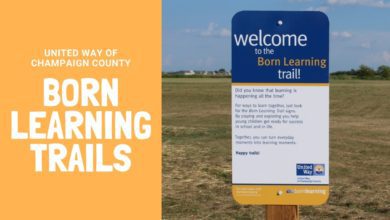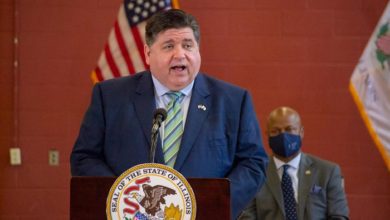Museum of the Grand Prairie learning tubs help teachers bring history to life

There are 61 schools in Champaign County with a little more than 25,000 students in grades K-12. But only one educational entity in Champaign County has all those students, their parents, their grandparents and their great-grandparents in mind: the Museum of the Grand Prairie.
Each year the Museum hosts exhibits, highlighting the development of land and the movements of people. Visitors from across East Central Illinois come to their building to learn about blacksmiths and to do traditional dances.
But what many people do not know about is the learning tubs that have been developed to help local teachers bring national history and its regional influencers to life.
Education Program Specialist Katie Snyder, a former classroom teacher, said that the tubs are available for classroom use, even under current models of learning, whether they be in-the-classroom or online.
The Museum has put together two civil rights boxes full of children’s books, secondary photographs and information about what happened locally during the 1950’s and 60’s as the nation worked towards social justice.
“There are so many great picture books about history these days,” Snyder said. “If you want to learn about history, read a children’s picture book because it condenses to 32 pages with really great illustrations and the illustrations are just kind of incredible.
“I think picture books can kind of come to kids, anywhere from kindergarten to 12th grade, in a way that they can understand. They don’t talk down to kids; they don’t talk down to adults.
“We also have photographs and explanations on the right to work in Champaign County, the right to housing, the right to education and the right to worship.”
The Museum pulls from photographs and stories in newspapers or other historical records to find stories of people who were taking those small steps to make big changes.
One Museum exhibit includes a story of the Smith family. A former slave in Tennessee, George Smith owned farmland in Broadlands. His son, William Walter Smith, became the first African-American to receive a degree from the University of Illinois in 1900.
While most children know the names of Martin Luther King Jr. and Rosa Parks, Snyder said that it’s equally important for them to know the names and accomplishments of people who lived and worked where they are growing up.
“I think it’s really interesting and more impactful for people to care about the stories of everyday people,” Snyder said.
“It’s the people that do the everyday work,” Snyder said. “In this time period we’re living through right now, what’s happening right now, you have everyday people that are doing the work to bring about real change in the world that we’re living in where is still a giant factor in our everyday lives.”
Snyder drew on her teaching background, literature paired with integrated art, to develop lesson outlines to help educators get the most out of the learning tubs. With collections of readers at all different levels, a teacher could choose to have students do individual projects or work collaboratively.
And the tubs can be checked out and used any time of the year.
“Issues of racial justice and social justice need to be embedded throughout the classroom throughout the year,” she said. “It should be part of what we’re teaching every single day as far as social justice.”
Among other topics, the Museum also has a tub about women’s issues and women’s rights. The 2020 exhibit, “How Long Must Women Wait” also highlights historical moments in time when local people rose to the occasion.
Snyder said that while schools are providing learning opportunities in new territories, the Museum is willing to meet them there. Although field trips will not be held at the Museum in the near future, she is available to supplement learning opportunities virtually for districts or classrooms that would like to enhance their curriculum.
Lincoln Trail Elementary teacher Bridget Graham advocated for all fifth-grade students to experience the civil rights field trip at the Museum in 2019. Previously, Graham’s class participated in the Immigration Field Trip.
Using the arts to reach students and elicit conversation, Snyder takes groups through the American civil rights movement on a national and local level.
The hour-and-a-half session highlights Norman Rockwell’s “New Kids in the Neighborhood”; the life of Billy Moore, a white man who was married to a black woman and what it was like to raise their children in Champaign; then local artifacts related to the civil rights movement in Champaign County.
Students also learn about the Douglas Center’s original purpose to support black soldiers coming back from World War Two who weren’t welcome in the VFW. Today, the Douglas Center is owned by the Champaign Park District.
“They had a drum and Bugle Corps, that was very very successful,” Snyder said.
The field trip usually ends with bucket drums, which Snyder said makes a lasting impression on the children.
Obviously, the drums can’t come to a virtual field trip, but Snyder said she is willing to provide other components of the field trip virtually.
Additionally, Snyder said that teachers are welcome to reach out to the Museum for additional supplemental materials on any historical event or time period.
“I’m often able to talk to a teacher and pull something together because we have a whole education collection,” she said.
With graduate work focused on integrating history and social studies with reading and writing, Snyder said that in a time where districts are focused on making sure students stay on par with basic skills, she can also help bring the world to life while not deviating from those goals.
“I can help find some motivating ways to bring reading and writing through history, into the classroom,” she said.
Snyder’s mission is to help children see that while history is remembered on the platform historical figures, local lives and voices have been the backbone that’s shaped and impacted what America looks like today.
“The Voting Rights Act of 1965 would never have happened if there weren’t the protests of the everyday people,” she said. “Lyndon Johnson signed that document, but Lyndon Johnson did not make that document happen.
“The everyday people that went to the protests, the citizens that fought for racial justice and fought for their right to vote because even though they were supposed to have the right to vote, African Americans did not have the right to vote.”
Snyder said that people may not always realize a historical moment or a moment that will ultimately affect the community they live in, but, looking back on historical moments, she does know that social justice change only comes when seeds are planted and collectively cultivated.
“Those things become the catalyst for change,” she said. “It’s about the everyday people that collectively make change.
“It’s not about the person who signs the document. It’s not often about the person that’s sitting in the White House. It’s about you. It’s about me. It’s about all the kids out there. It’s about the teachers that decide to bring this kind of curriculum to their students. Even when sometimes they’re getting pushed up against. That’s not an easy thing to do.
“And I applaud those teachers, I applaud those educators, and I applaud those board members that stand up for the right for teachers to educate all children in all children’s history.”
Whether or not 2020 will have a lasting impact on the way humans organize their life together remains to be seen. Snyder said she believes that with everything from COVID-19 to social issues at the forefront of every news story, the world is in a moment.
The Museum is actively collecting artifacts from the present, cataloging them and in hopes that one day children will be able to see the faces and read the stories of people working to make a difference.
To inquire about the Museum of the Grand Prairie learning tubs or field trips, contact Katie Snyder at KSnyder@ccfpd.org.





